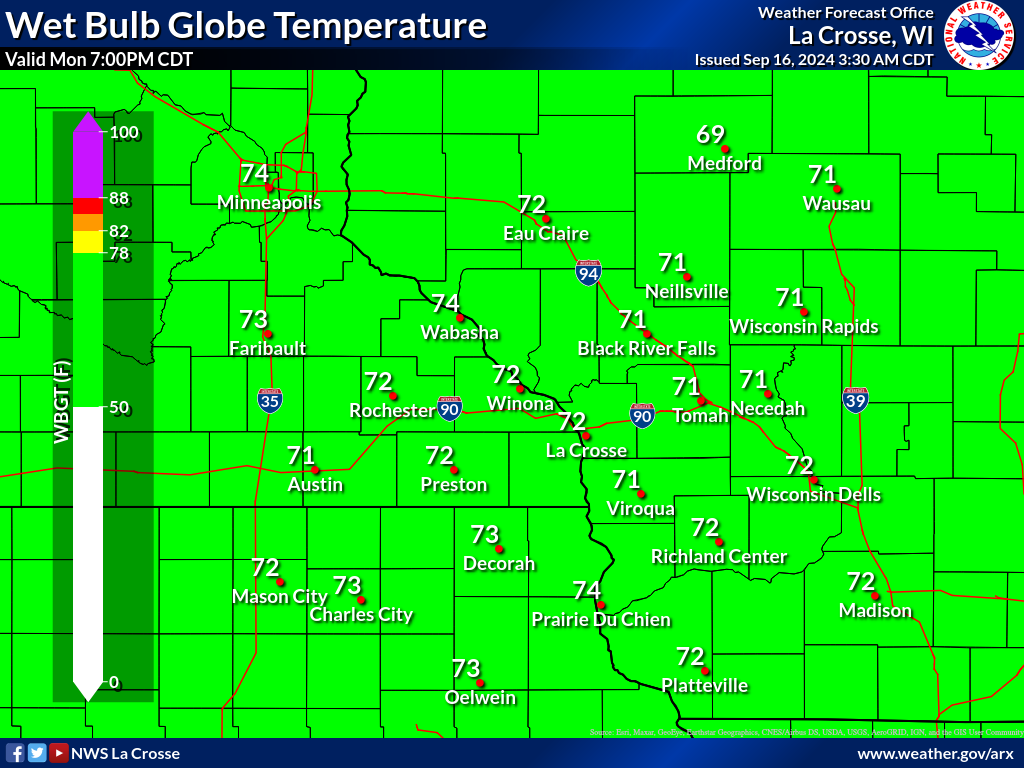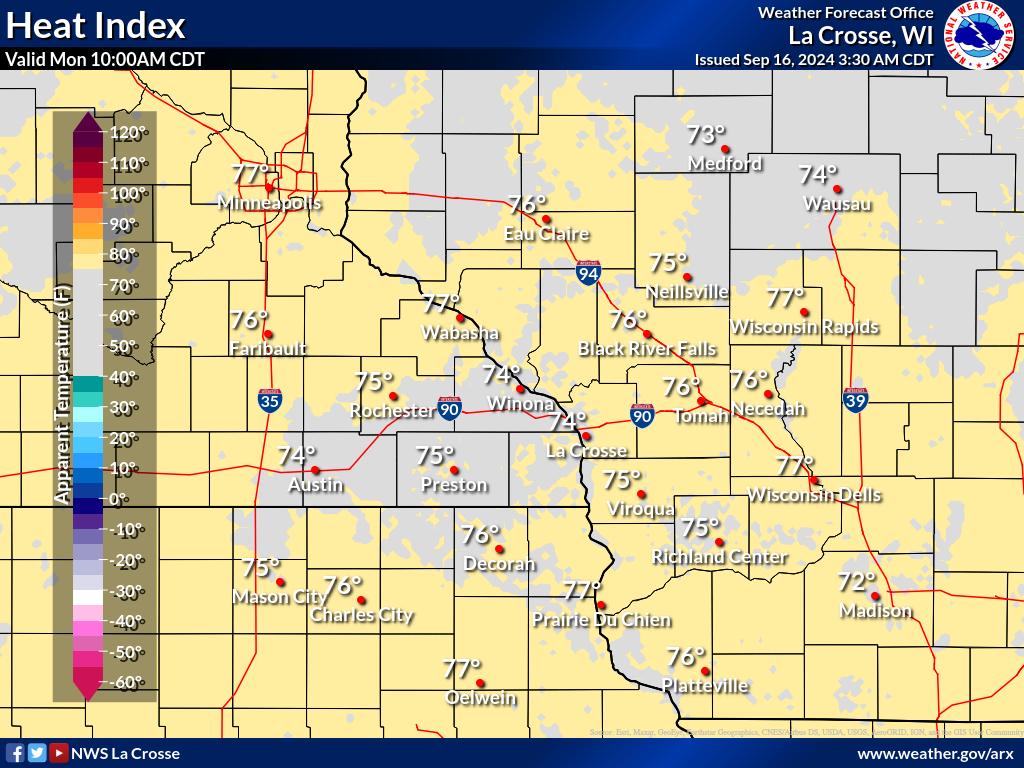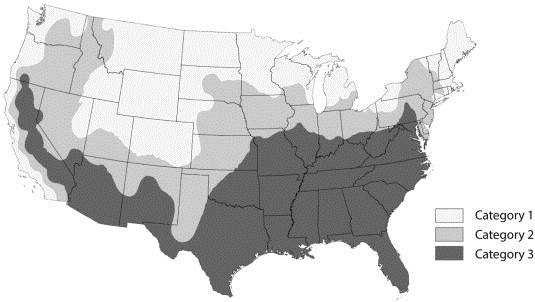EXCESSIVE HEAT: Wet Bulb Globe Temperature & Heat Index
The Wet Bulb Globe Temperature (WBGT) is an indicator of heat related stress on the human body at work (or play) in direct sunlight. It takes into account multiple atmospheric variables, including: temperature, humidity, wind speed, sun angle, and cloud cover.
The Heat Index is more commonly known and used as an indicator of extreme heat and potential health related impacts but only takes into account temperature (measured in the shade) and relative humidity.
What value should you use? For day-to-day activities, heat index will serve you well. If you work outside or plan on any sort of vigorous outdoor activity in the full sun, use the WBGT.
Wet Bulb Globe Temperature & Heat Index
|
|
|
|||||||||||||||||||||||||||||||||||||
Map, calculator courtesy National Weather Service - Tulsa
MAPS
Need HOURLY forecast maps for WBGT, Heat Index and other weather elements? Check this out.Wet Bulb Globe Temps
 7 am |
 10 am |
 1 pm |
 4 pm |
 7 pm |

|

|

|
Heat Index
 7 am |
 10 am |
 1 pm |
 4 pm |
 7 pm |

|

|

|
Wet Bulb Globe Temperature vs Heat Index
While the WBGT and Heat Index both attempt to describe how "hot" it is and the potential for heat related stresses, they go about it in different ways.
â–º Heat Index is more commonly used and understood by the general public - the higher the values the hotter it's going to feel and the higher the threat for heat related illnesses. It's calculated from the temperature and relative humidity. What's not commonly known is that Heat Index assumes you are in the shade.
â–º WBGT also uses the temperature and humidity in its calculation, but temperatures are measured in direct sunshine. It also factors in wind speed, sun angle, and cloud cover.
Bottom-line upfront >>>> what value should you use? For day-to-day activities, heat index will serve you well. If you work outside or plan on any sort of vigorous outdoor activity in the full sun, use the WBGT.
Comparing WBGT and Heat Index
|
Examples
|
| WBGT | Heat Index | |
|
Origins: The WBGT date back to the 1950s - specifically the United States Marine Corp Recruit Depot on Parris Island, SC. There, recruits were required to perform high intensity exercise in a high humidity, high temperature environment. Many solders succumbed to heat related illness. In response, a joint effort between the Department of the Navy and Army doctors studied the effects of heat on exercise performance. The result was the WBGT. WGBT uses several atmospheric variables for its calculations: temperature, humidity, wind speed, sun angle, and cloud cover. Temperatures are measured in the sunlight. The military uses the WBGT to gauge the potential for heat related stresses to this day. OSHA and many nations also use the WBGT as a guide to managing workload in direct sunlight, as do athletic departments (college and high school) and events. If you work or exercise in direct sunlight, this is a good element to monitor. |
Origins: The Heat Index is based on work carried out by Robert G. Steadman in 1979 ("An Assessment of Sultriness, Parts I and II") where he discussed factors that would impact how hot a person would feel under certain conditions. The National Weather Service developed a "simplified" formula from this work using air temperature and relative humidity as the two inputs. This formula became the "heat index". It is important to note that the heat index is calculated for shady areas. Direct sunlight can add as much as 15 degrees to the heat index. |
|
Inputs:
|
Inputs:
|
|
|
Equation: WBGT=0.7Tw+0.2Tg+0.1Td
|
Equation: Heat Index = -42.379 + 2.04901523T + 10.14333127R – 0.22475541TR – 6.83783(10-3T2) – 5.481717(10-2R2) + 1.22874(10-3T2R) + 8.5282(10-2TR2) – 1.99(10-6T2R2)
|
PREPARE - SAFETY - RESOURCES
Prepare
Before:
During:
Resources
WBGT Guidelines - Charts
While there is not set criterion for WBGT temperatures and related risks/impacts, the American College of Sports Medicine (ACSM) has developed a set of values that have been accepted as a standard to follow. Their original guidelines were developed for running events, but have since been expanded to include intermittent (non-continuous) activities [Medicine & Science in Sports & Exercise: March 2007 - Volume 39 - Issue 3 - p 556-572] . The guidelines are not based on location.
Using ACSM as a starting point, further research by the University of Georgia (UGA) factored in climatology and regional differences in an effort to incorporate acclimatization* into the guidelines. The Korey Stringer Institute and USA Soccer used the regional categories developed by UGA to provide another set of recommend actions.
The military and OSHA also have devised recommendations, as do many university and high school athletic departments.
Below you will find several of these guidelines/recommendations.
It should be noted that while WBGT will provide solid guidelines, other factors such as an individual’s physical fitness, acclimatization, medical condition, and age also have an impact.
* Acclimatization: the body's natural adaptation to heat/cold. The process usually takes 10 to 14 days.
NOT based on location - American College of Sports Medicine
| Continuous Activities | Intermittent Activities | |
|
Activities with little if any break, such as cross country running, 5K runs, and marathons. |
Activities that generally have breaks between bursts of high intensity movements/actions, such as football, soccer, lacrosse, etc. |
|
 |
 |
|
|
Guidelines from the American College of Sports Medicine - not based on location |
Guidelines from the American College of Sports Medicine - not based on location |
Based On Location
| The following recommendations use similar criteria as the ACSM, but modified for location and climatology. This adjustment factors in the acclimatization that occurs for those that consistently work and exercise in hot environments. |  Regional Categories |
 |
 |
|
|
Guidelines from USA Soccer and the Korey Stringer Institute (KSI) |
Guidelines from the University of Georgia |
Other Charts For Reference
|
|
|
|
Heat Index Guidelines - Charts
How to read the chart: find the temperature on the left hand side, then move to the right until you find the column for the approximate relative humidity. That number will be the temperature that it will "feel" like. Example: A temperature of 95 and relative humidity of 50% will "feel" like 107 degrees.
| 0% | 5% | 10% | 15% | 20% | 25% | 30% | 35% | 40% | 45% | 50% | 55% | 60% | 65% | 70% | 75% | 80% | |
| 115 | 103 | 107 | 111 | 115 | 120 | 127 | 135 | 143 | 151 | ||||||||
| 110 | 99 | 102 | 105 | 108 | 112 | 117 | 123 | 130 | 137 | 143 | 151 | ||||||
| 105 | 95 | 97 | 100 | 102 | 105 | 109 | 113 | 118 | 123 | 129 | 135 | 142 | 149 | ||||
| 100 | 91 | 93 | 95 | 97 | 99 | 101 | 104 | 107 | 110 | 115 | 120 | 126 | 132 | 136 | 144 | ||
| 95 | 87 | 88 | 90 | 91 | 93 | 94 | 96 | 98 | 101 | 104 | 107 | 110 | 114 | 119 | 124 | 130 | 136 |
| 90 | 83 | 84 | 85 | 86 | 87 | 88 | 90 | 91 | 93 | 95 | 96 | 98 | 100 | 102 | 106 | 109 | 113 |
| 85 | 78 | 79 | 80 | 81 | 82 | 83 | 84 | 85 | 86 | 87 | 88 | 89 | 90 | 91 | 93 | 95 | 97 |
| 80 | 73 | 74 | 75 | 76 | 77 | 77 | 78 | 79 | 79 | 80 | 81 | 81 | 82 | 83 | 85 | 86 | 86 |
| 75 | 69 | 69 | 70 | 71 | 72 | 72 | 73 | 73 | 74 | 74 | 75 | 75 | 76 | 76 | 77 | 77 | 78 |
| 70 | 64 | 64 | 65 | 65 | 66 | 66 | 67 | 67 | 68 | 68 | 69 | 69 | 70 | 70 | 70 | 70 | 71 |
IMPORTANT: Heat index values were devised for shady, light wind conditions. Exposure to full sunshine can increase values by up to 15 degrees! Also, strong winds, particularly with very hot, dry air, can be extremely hazardous.
Dew Point vs. Humidity
The dew point is the temperature the air needs to be cooled to (at constant pressure) in order to achieve a relative humidity (RH) of 100%. At this point the air cannot hold anymore water in the gas form. If the air were to be cooled even more, water vapor would have to come out of the atmosphere in the liquid form, usually as fog or precipitation.
The higher the dew point rises, the greater the amount of moisture in the air. This directly effects how "comfortable" it will feel outside. Many times, relative humidity can be misleading. For example, a temperature of 30 and a dew point of 30 will give you a relative humidity of 100%, but a temperature of 80 and a dew point of 60 produces a relative humidity of 50%. It would feel much more "humid" on the 80 degree day with 50% relative humidity than on the 30 degree day with a 100% relative humidity. This is because of the higher dew point.
So if you want a real judge of just how "dry" or "humid" it will feel outside, look at the dew point instead of the RH. The higher the dew point, the muggier it will feel.
General comfort levels that can be expected during the summer months:
Heat Index/Heat Disorders
| Heat Index | Possible heat disorders for people in higher risk groups |
| 80-90 | Fatigue possible with prolonged exposure and/or physical activity. |
| 90-105 | Sunstroke, heat cramps and heat exhaustion possible with prolonged exposure and/or physical activity. |
| 105-130 | Sunstroke, heat cramps or heat exhaustion likely, and heat stroke possible with prolonged exposure and/or physical activity. |
| 130 or higher | Heatstroke/sunstroke highly likely with continued exposure. |
| Heat Disorder | Symptoms | First Aid |
|---|---|---|
| Sunburn | Redness and pain. In severe cases swelling of skin, blisters, fever, and headaches. | Ointments for mild cases if blisters appear and do not break. If breaking occurs, apply dry sterile dressings. Serious, extensive cases should be seen by a physician. |
| Heat Cramps | Painful spasms usually in muscles of the legs and abdomen possible. Heavy sweating. | Firm pressure on the cramping muscles, or gentle massaging to relieve the spasm. Give sips of water. If nausea occurs, discontinue use. |
| Heat Exhaustion | Heavy sweating, weakness, skin cold, pale and clammy. Pulse thready. Normal temperature possible. Fainting and vomiting. | Get victim out of sun. Lay down and loosen clothing. Apply cool, wet cloths. Fan or move victim to air conditioned room. Sips of water. If nausea occurs, discontinue use. If vomiting continues, seek immediate medical attention. |
| Heat Stroke (sunstroke) | High body temperature (106 F or higher). Hot dry skin. Rapid and strong pulse. Possible unconsciousness. | Heat stroke is a severe medical emergency. Summon emergency medical assistance or get the victim to a hosiptal immediately. Delay can be fatal.
Move the victim to a cooler environment. Reduce body temperature with cold bath or sponging. Use extreme caution. Remove clothing, use fans and air conditioners. If temperature rise again, repeat process. Do not give fluids. |
Safety Tips